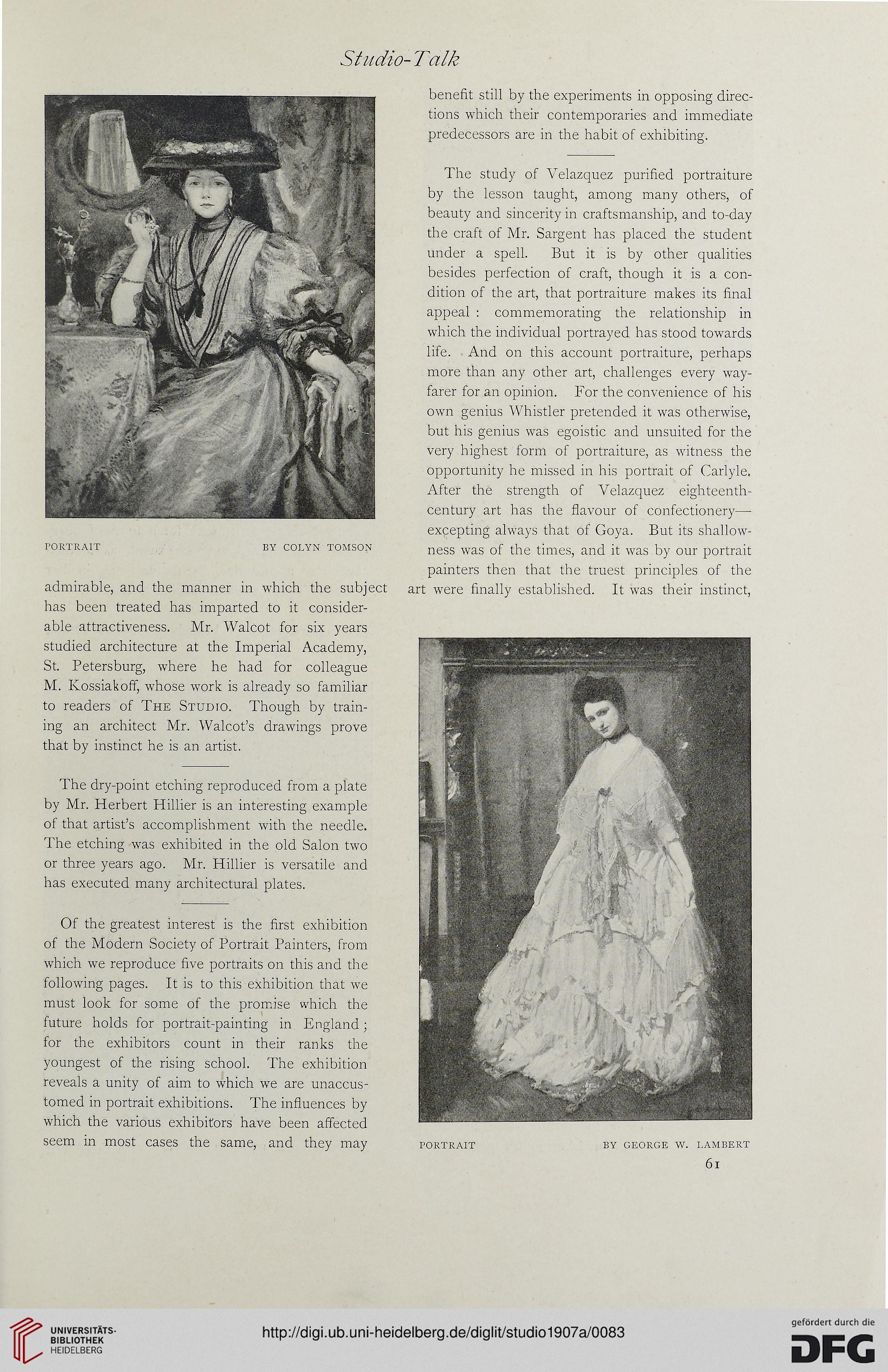Studio-Talk
PORTRAIT BY COLYN TOMSON
admirable, and the manner in which the subject
has been treated has imparted to it consider-
able attractiveness. Mr. Walcot for six years
studied architecture at the Imperial Academy,
St. Petersburg, where he had for colleague
M. Ivossiakoff, whose work is already so familiar
to readers of The Studio. Though by train-
ing an architect Mr. Walcot’s drawings prove
that by instinct he is an artist.
The dry-point etching reproduced from a plate
by Mr. Herbert Hillier is an interesting example
of that artist’s accomplishment with the needle.
The etching was exhibited in the old Salon two
or three years ago. Mr. Hillier is versatile and
has executed many architectural plates.
Of the greatest interest is the first exhibition
of the Modern Society of Portrait Painters, from
which we reproduce five portraits on this and the
following pages. It is to this exhibition that we
must look for some of the promise which the
future holds for portrait-painting in England;
for the exhibitors count in their ranks the
youngest of the rising school. The exhibition
reveals a unity of aim to which we are unaccus-
tomed in portrait exhibitions. The influences by
which the various exhibitors have been affected
seem in most cases the same, and they may
benefit still by the experiments in opposing direc-
tions which their contemporaries and immediate
predecessors are in the habit of exhibiting.
The study of Velazquez purified portraiture
by the lesson taught, among many others, of
beauty and sincerity in craftsmanship, and to-day
the craft of Mr. Sargent has placed the student
under a spell. But it is by other qualities
besides perfection of craft, though it is a con-
dition of the art, that portraiture makes its final
appeal : commemorating the relationship in
which the individual portrayed has stood towards
life. And on this account portraiture, perhaps
more than any other art, challenges every way-
farer for an opinion. For the convenience of his
own genius Whistler pretended it was otherwise,
but his genius was egoistic and unsuited for the
very highest form of portraiture, as witness the
opportunity he missed in his portrait of Carlyle.
After the strength of Velazquez eighteenth-
century art has the flavour of confectionery—-
excepting always that of Goya. But its shallow-
ness was of the times, and it was by our portrait
painters then that the truest principles of the
art were finally established. It was their instinct,
PORTRAIT BY CEORGE W. LAMBERT
61
PORTRAIT BY COLYN TOMSON
admirable, and the manner in which the subject
has been treated has imparted to it consider-
able attractiveness. Mr. Walcot for six years
studied architecture at the Imperial Academy,
St. Petersburg, where he had for colleague
M. Ivossiakoff, whose work is already so familiar
to readers of The Studio. Though by train-
ing an architect Mr. Walcot’s drawings prove
that by instinct he is an artist.
The dry-point etching reproduced from a plate
by Mr. Herbert Hillier is an interesting example
of that artist’s accomplishment with the needle.
The etching was exhibited in the old Salon two
or three years ago. Mr. Hillier is versatile and
has executed many architectural plates.
Of the greatest interest is the first exhibition
of the Modern Society of Portrait Painters, from
which we reproduce five portraits on this and the
following pages. It is to this exhibition that we
must look for some of the promise which the
future holds for portrait-painting in England;
for the exhibitors count in their ranks the
youngest of the rising school. The exhibition
reveals a unity of aim to which we are unaccus-
tomed in portrait exhibitions. The influences by
which the various exhibitors have been affected
seem in most cases the same, and they may
benefit still by the experiments in opposing direc-
tions which their contemporaries and immediate
predecessors are in the habit of exhibiting.
The study of Velazquez purified portraiture
by the lesson taught, among many others, of
beauty and sincerity in craftsmanship, and to-day
the craft of Mr. Sargent has placed the student
under a spell. But it is by other qualities
besides perfection of craft, though it is a con-
dition of the art, that portraiture makes its final
appeal : commemorating the relationship in
which the individual portrayed has stood towards
life. And on this account portraiture, perhaps
more than any other art, challenges every way-
farer for an opinion. For the convenience of his
own genius Whistler pretended it was otherwise,
but his genius was egoistic and unsuited for the
very highest form of portraiture, as witness the
opportunity he missed in his portrait of Carlyle.
After the strength of Velazquez eighteenth-
century art has the flavour of confectionery—-
excepting always that of Goya. But its shallow-
ness was of the times, and it was by our portrait
painters then that the truest principles of the
art were finally established. It was their instinct,
PORTRAIT BY CEORGE W. LAMBERT
61




